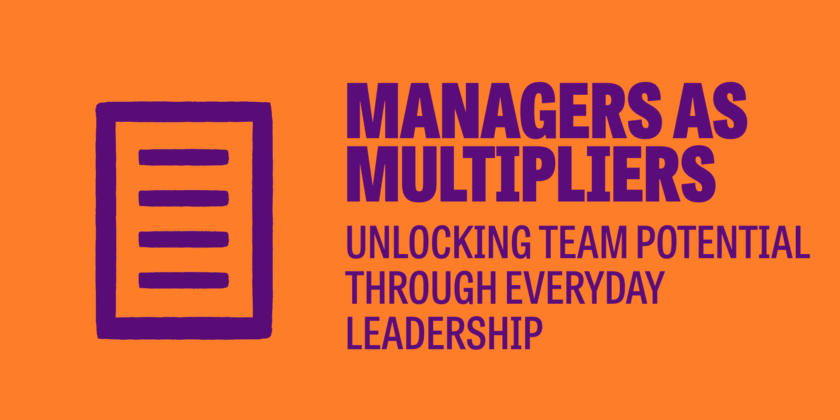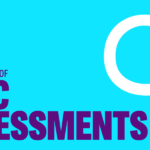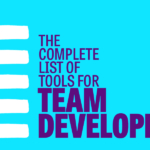I often look back on leaders who have shaped me – those who saw something in me before I saw it myself. The ones who pushed me into stretch roles, asked questions instead of giving orders, celebrated small wins, and believed I could grow, even when I failed. Because of them, I grew. I learned, I failed, I tried, and I stretched.
Then there were the others (unfortunately multiple): those whose leadership, whether through micromanagement, withholding feedback, favouring control over trust, or simply not paying attention, made me shrink. Creativity got squashed, enthusiasm was stolen, confidence wore thin, and potential stayed hidden.
These personal experiences made one thing very clear to me: managers have an extraordinary impact on people, often more than they realise. Their behaviours, mindset, and daily choices either unlock possibilities or limit them. Managers are not just crisis-managers or order-givers, they are central to individual growth, team performance, and ultimately business success.
As we head into 2026, in a VUCA (volatile, uncertain, complex and ambiguous) world of hybrid working, rapid change, technological shifts, and higher expectations from teams, the need for ‘multiplying’ leadership has never been more urgent.
The number of conversations I have with leaders about empowering their managers to drive high performance and change is fantastic but also worrying. The difference between a team that excels and one that just gets by often comes down to whether their manager is a multiplier or (sometimes unknowingly) a diminisher.
Why It Matters
According to Gallup’s 2025 State of the Global Workplace Report, manager engagement dropped from 30% to 27%, contributing to a fall in overall employee engagement from 23% to 21%. Teams with more engaged managers see higher engagement in their people.
In the same report, the global cost of lost productivity due to disengagement was estimated in the hundreds of billions of dollars.
Leadership-development statistics show that organisations with strong leadership are significantly more profitable and outperform competitors.
These numbers tell us that multiplying isn’t a ‘nice to have’ – it’s a competitive edge. One that almost all organisations can benefit from, with the right support.
What Is a Multiplier?
In my eyes, I see a multiplier as a leader who:
- Believes in their people and seeks to bring their unique and best parts forward
- Creates space for others to think, decide, experiment, and own outcomes
- Enhances not just performance, but collective intelligence, collaboration, ownership, and motivation
In contrast, a diminisher tends to:
- Dominate conversations, solve all problems themselves, and restrict autonomy
- Instil fear of failure rather than curiosity
- Limit feedback, stifle innovation, and drain morale, even if unintentionally
Real-World Examples: The Power of Multiplying vs. Diminishing
The Inspiring Manager
I once worked for a leader guiding us through a major private equity buyout – a time of uncertainty, shifting priorities, and high stakes.
Before each new phase of change, they were open and honest about what was coming and what it meant for our team. Instead of dictating plans, they’d ask: ‘What part of this do you want to lead on this time?’
They didn’t just assign tasks; they invited co-ownership. I was encouraged to co-design my deliverables, deciding which areas I felt confident leading and where I needed support. Every project was a stretch, but I felt trusted.
When I made missteps, they framed them as learning moments, not failures. The message was clear: ‘You’ve got this, and even if you don’t yet, we’ll learn together.’
That experience fundamentally changed how I saw myself. My confidence grew. I became more creative, proactive, and resilient. It was the moment I realised what leadership done well could really do – not just for results, but for people.
The Limiting Boss
Then there was another manager, one who led through fear and control.
When they saw underperformance in my team, their first reaction wasn’t curiosity, it was command. Without understanding the root causes, they introduced four daily check-ins, each focused on metrics, not people. The tone was tense, defensive, and punitive.
They began making decisions about my team, even attempting to remove individuals, without my knowledge or input. Trust evaporated overnight.
Soon, I stopped taking initiative. I stopped sharing ideas. It was safer to comply than contribute. My motivation faded, my growth stalled, and eventually, I left.
That experience showed me just how quickly potential can shrink under the wrong kind of leadership.
The Path Forward: From Diminisher to Multiplier
When I speak to friends, colleagues, and clients, I’m often struck by how many have experienced the latter – leaders who limit rather than lift. Sadly, diminisher behaviours are still more common than we’d like to admit in the workplaces of today.
But here’s the good news: it doesn’t have to stay that way. Most diminishers don’t wake up intending to suppress creativity or control outcomes; they’re often doing what they believe leadership looks like, shaped by pressure, pace, or past experience.
With the right support, guidance, and reflection, these managers can evolve into the inspiring leaders their teams deserve. With coaching, feedback, and practical tools, they can learn to ask instead of tell, trust instead of control, and develop instead of direct.
The potential to multiply others exists in all of us. Leadership isn’t fixed – it’s a practice. And when managers choose to lead with curiosity, trust, and belief in others, they don’t just change the way people work; they change the way people feel about work.
What Are the Key Multiplying Behaviours?
Here are concrete behaviours that distinguish multipliers. These are things managers can start doing (or stop doing) immediately.
| Pillar | Specific Behaviours | What It Looks Like |
|---|---|---|
| Ask, Don’t Tell | Powerful Questioning | Asking open-ended questions: ‘How might you approach this?’, ‘What do you think is the root problem?’ |
| Pause & Wait | Allowing silence in meetings so others can think and contribute, instead of filling it all yourself | |
| Delegate & Trust | Outcome Delegation | Delegating responsibilities with clear outcomes, not micromanaging how the work is done |
| Letting Go of Perfection | Accepting ‘good enough’ in draft or iteration to allow experimentation | |
| Recognise & Amplify Strengths | Spot & Verbally Name Strengths | Calling out strengths in public or in reviews, aligning tasks with people’s growth areas |
| Stretch Assignments | Giving tasks or roles that stretch someone beyond their current comfort zone, but with support | |
| Listen to Learn | Active Listening | Listening to understand: asking clarifying follow-ups, not interrupting, acknowledging other views |
| Soliciting Feedback | Encouraging feedback from the team about the manager’s style, what’s working, what isn’t | |
| Challenge with Support | Set High Expectations + Support | Clear goals, high standards, but backing people with resources and coaching |
| Treat Mistakes as Learning Opportunities | When things go wrong, focusing on ‘what did we learn?’ rather than blame |
These behaviours will come more naturally to some people; however, with the right skill development and supporting structures, you can set the right environment for success for all your managers.
Addressing Limiting Behaviours at Different Levels
If, when looking at your managers, the limiting behaviours are in pockets and you believe that these individuals have just got into bad habits and need some support, take a look at running some skill development sessions or even some targeted coaching. Investing in your managers is a lot more cost-effective than losing team members.
If, when you look at the organisation, the limiting behaviours are more deep-rooted, this will require more focused attention. Start from your foundations of how you work. Are your values right? Are they lived by your team? Do you have the right behaviour and competency frameworks in place to showcase what good looks like? Does your culture support multipliers?
One thing is clear: when making big changes like this, you usually get one shot to get it right, so invest in the support when you need it. Whether that’s someone to mark your homework, co-design, or outsourced help, we’re here to support your journey.
Everyday Habits and Team Impact
If you’re not ready for investment or have no resources at the moment, there are some quick wins that will enable you to change behaviours into habits. When they are repeated daily, they build culture. Here are specific habits and their impacts:
5 Practical Habits to Start Today
- One-to-ones that start with the team member’s agenda (not the manager’s).
Impact: Boosts ownership, reveals what’s top of mind, helps leaders ‘see’ challenges early. - Quick weekly feedback & recognition (even 30 seconds).
Impact: Reinforces behaviour, builds confidence, keeps momentum. - Delegating decisions: Let team members make decisions in their domain.
Impact: Increases accountability, speeds up agility, builds decision-making capability. - After-action reflections: what went well, what didn’t, what we learned.
Impact: Accelerates improvement, builds psychological safety. - Regular ‘What if’ questions: ‘What if we tried it this way?’, ‘What if failure was acceptable for learning?’, ‘What if we owned the outcome rather than waiting for direction?’
Impact: Encourages innovation, breaks habitual thinking, increases creative problem-solving.
Top tip: Start with small steps. If team members see a big change too quickly, eyebrows will raise and people will be cautious to engage as it feels too out of character.
How Let’s Talk Talent Can Help
At Let’s Talk Talent, our programmes and initiatives are designed to help managers become Multipliers through:
- Assessment & Self-Awareness Tools: We use tools like 360 feedback, leadership style diagnostics, profiling tools and more to help managers understand how they are currently showing up and we support them to identify behavioural changes.
- Coaching & Peer Learning: One-to-one coaching and learning circles where managers can work on their development, try out multiplier behaviours, and share wins and challenges.
- Structured Frameworks: From values and behaviours through to competencies and capability frameworks, we support organisations to set the right foundations to support managers to be multipliers of talent and provide clarity on what great looks like, how to adopt it, and why.
- Behaviour Reinforcement & Culture Change: Not just training, but embedding recognition, feedback, and leadership habits into culture and everyday work, ensuring it becomes your DNA, not pockets of great leadership.
Your Next Steps
- If You’re a Manager: Pick one multiplying behaviour above and try it for the next week. Reflect daily: What went well? What resisted change? Invite feedback from one team member.
- If You Lead or Influence Leadership Development: Embed multiplier training into your programmes.
- For Organisations: Invest in leadership development, not as a checkbox, but as a strategic priority. Align organisational processes – rewards, recognition, performance reviews – with multiplying behaviours.
Lost and Don’t Know Where to Start?
Get in touch, explore our Manager Development Programmes or take a look at our targeted leadership coaching or deeper culture and change work. Let’s unlock potential together for your people, your teams, and your business.
Final Thoughts
One of the most powerful lessons I’ve learnt is that leadership is not about being right. It’s about making others brilliant. Multipliers don’t just lead – they lift, they enable, and they expand what’s possible.
When you multiply the potential of your people, you multiply the potential of your business.
If you’re ready to be that kind of manager in 2026 (and beyond), start small, stay consistent, and watch what unfolds.



